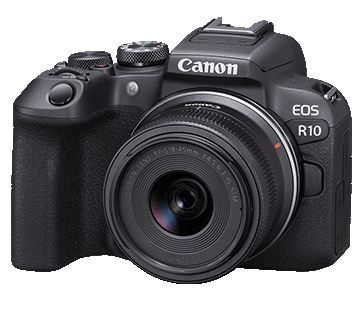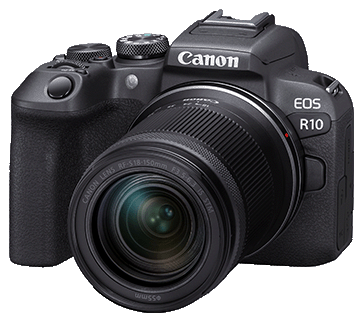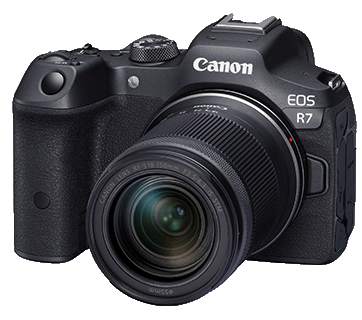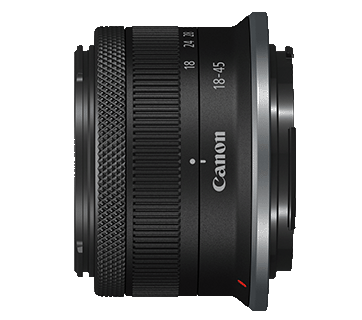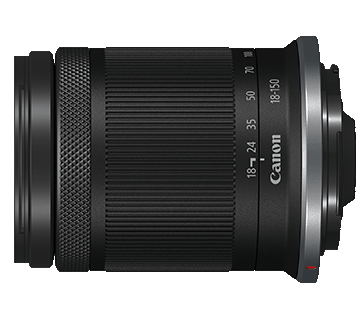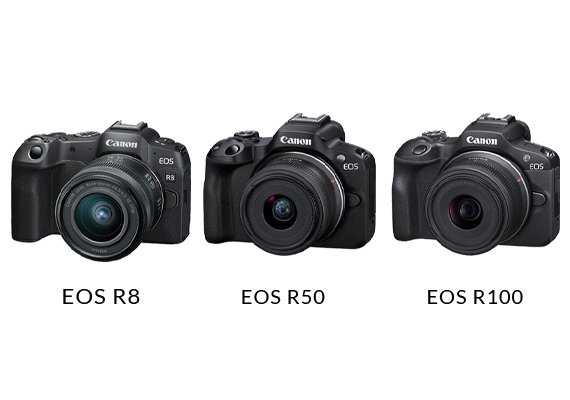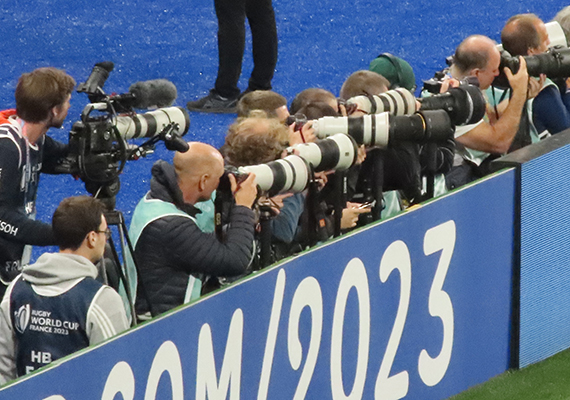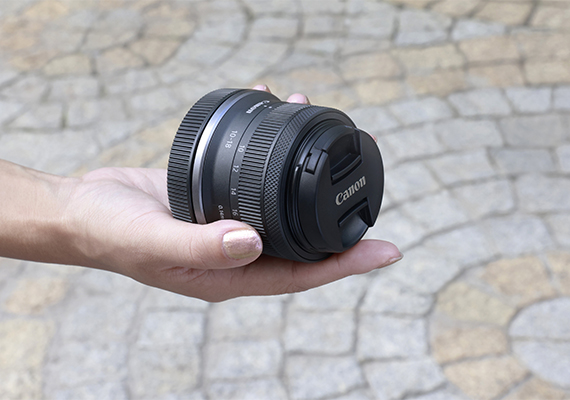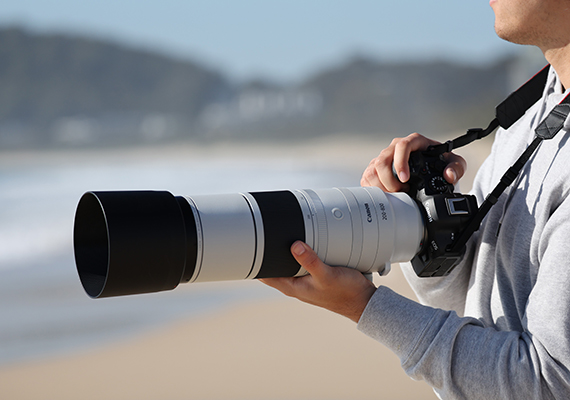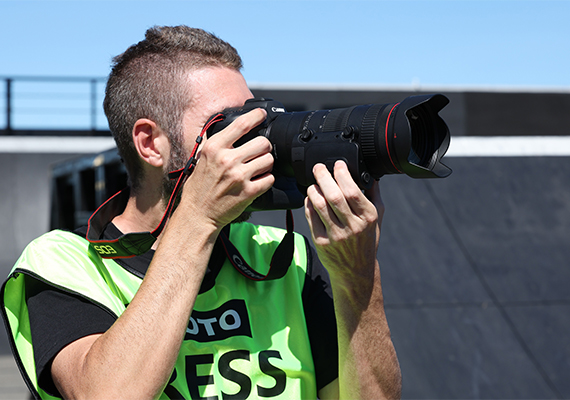Canon’s EOS R(evolution) Expands to APS-C with Its Two New Mirrorless Cameras and New RF-S Lenses
Smaller and lighter but no less powerful, the EOS R7 and EOS R10, accompanied by two new kit lens options, combine the excellent image quality and functionality of the EOS R system with the benefits of an APS-C image sensor
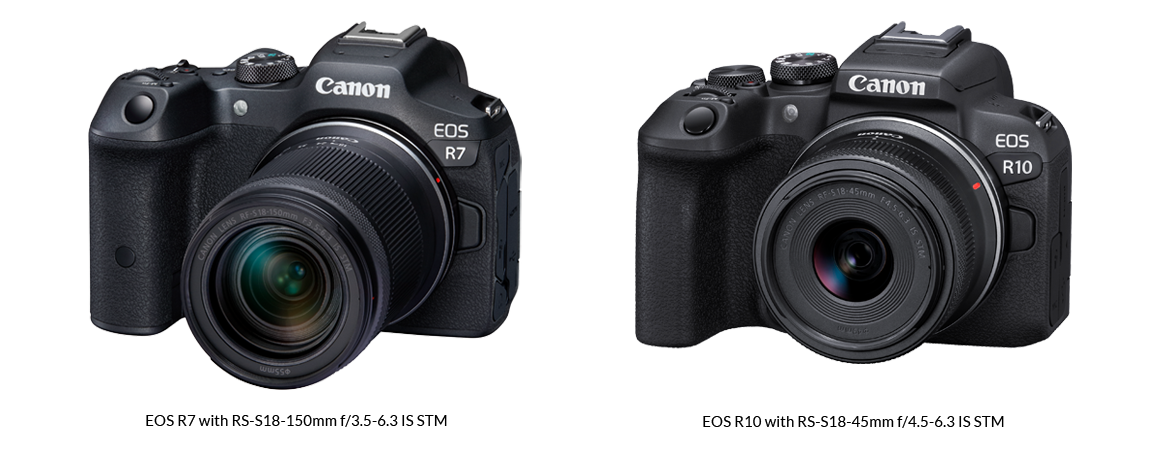
Singapore, 24 May 2022 — Canon today announced the launch of the EOS R7 and the EOS R10, its first cameras in the EOS R mirrorless system to be equipped with APS-C image sensors.
Designed for more experienced users who require a fast camera to photograph dynamic subjects such as sports and wildlife, the high-performance 32.5-megapixel EOS R7 features In-Body Image Stabilization (In-Body IS), weather-sealing, and dual SD card slots. The 24.2-megapixel EOS R10, which features a built-in flash and a smaller form factor, is designed for more standard everyday needs. Launched alongside the two cameras are the RF-S18-45mm f/4.5-6.3 IS STM and RF-S18-150mm f/3.5-6.3 IS STM, two new lenses built to fully optimise the mobility advantages of the new APS-C cameras.
"EOS R7 and EOS R10 marks a significant evolution of the EOS R system. With the addition of these APS-C mirrorless cameras to the EOS R system, there are many opportunities in Singapore for them to shine. The APS-C segment is favoured by many photographers for the smaller form factor, affordability, and advantages such as increased reach for genres like sports and wildlife. With otters and a plethora of birds in Singapore to photograph, these APS-C cameras will provide budding photographers with an affordable step into our mirrorless R system. In addition to the new native RF-S lenses, the wide range of compatible EF and EF-S lenses via mount adapter also means an enlarged ecosystem of lenses to explore and express your photographic vision." said Edwin Teoh, Head of Marketing, Singapore Operations, Canon Singapore.
Inheriting the AF technology of the EOS R3
Supported by the powerful DIGIC X image processing engine, the EOS R7 and EOS R10 are the first to inherit the new autofocusing (AF) technology that debuted on the EOS R3. This technology harnesses the deep learning-based subject detection capabilities of the EOS iTR AF X system – to track subjects more tenaciously across the entire image area, regardless of the AF area mode. This provides highly responsive and reliable autofocusing, even in dynamic scenes.
High-speed Continuous Shooting; RAW burst mode
Both the EOS R7 and EOS R10 are capable of up to 1fps high-speed continuous shooting in mechanical and electronic first-curtain shutter modes (with AF/AE tracking)—the fastest speed not just among all APS-C EOS cameras, but also in the EOS R series1. This is nearly equivalent to the EOS-1D X Mark III, Canon’s flagship DSLR, which shoots up to approx. 16fps with the optical viewfinder.
In electronic shutter mode, the EOS R7 is capable of shooting 32.5-megapixel images at up to approximately 30fps continuous shooting, whereas the EOS R10 shoots 24.2-megapixel images at up to approximately 23fps2.
Both cameras feature a RAW burst mode, which shoots full-resolution RAW images at up to 30fps. The mode supports pre-shooting, which starts recording the scene up to 0.5 second before the shutter is released, aiding the capture of unexpected opportunities.
Newly Developed APS-C CMOS sensors and DIGIC X
Both the EOS R7 and EOS R10 utilise newly developed APS-C CMOS image sensors that are 32.5 and 24.2 megapixels respectively. When combined with the DIGIC X image processing engine, they achieve image quality and visual resolution beyond what the megapixel count suggests. The visual resolution of the EOS R7 surpasses that of the EOS 90D and the EOS M6 Mark II despite having the same megapixel resolution, whereas that of the EOS R10 is equivalent to the same two cameras. Silky hair, fabric textures, and other fine details can be captured with precision and sharpness.
Image Stabilisation
The EOS R7 is the first APS-C EOS camera to feature the sensor-shift type 5-axis In-Body IS (Image Stabilizer) mechanism, which can achieve up to 8 stops’ equivalent image stabilisation3 during video and still image shooting. Both the EOS R7 and EOS R10 feature Movie Digital IS, which conducts 5-axis image stabilisation for steadier videos even with a lens that has no Optical Image Stabilizer (Optical IS).
Superior Video Quality
For content creators particular about video quality, the EOS R7 can use 7K oversampling to record high-quality 4K UHD video at up to 30p in the new 4K UHD Fine mode. Uncropped 4K 60p recording is possible in 4K UHD Standard mode. It is also the first APS-C EOS photography camera to support the Canon Log 3 gamma, good for colour grading and HDR video production.
Meanwhile, the EOS R10 is capable of high-quality 4K UHD Fine 30p video achieved by 6K oversampling. Both cameras are capable of 4K HDR PQ video recording.
The Built-in Telephoto Effect: Longer Reach with the Full Camera Resolution
A strength of APS-C sensor cameras is their inherent telephoto effect, which is just like having a built-in extender. This will greatly benefit users who frequently photograph wildlife and other subjects that require longer focal lengths. The field of view is automatically “zoomed in” by about 1.6 times the focal length indicated on the lens. On the other hand, unlike using the 1.6x crop mode on full-frame EOS R cameras, recording uses the full resolution of the image sensor.
When shooting video on the EOS R7, the inherent 1.6x APS-C crop can be combined with the 4K UHD crop mode for an even stronger telephoto effect of around 1.8 times that of the focal length.
Better Portability and Affordability
APS-C image sensors are roughly 40% the size of 35mm full-frame image sensors, allowing the camera and lens systems built around them to be smaller, lighter, more portable, and easier to handle. This also translates to better affordability.
By optimising material use and structural design, Canon has further reduced the weight of the cameras compared to their DSLR equivalents. The improvement in handling ease is multiplied when combined with one of the new RF-S kit lenses, which reduces total weight by as much as 24%.
| EOS R7: Approx. 612g EOS 90D: Approx. 701g (Approx. 12% lighter) |
EOS R7 + RF-S18-150mm f/3.5-6.3 IS STM: Approx. 922g EOS 90D + EF-S18-135mm f/3.5-5.6 IS USM: Approx. 1,216g (Approx. 24% lighter) |
| EOS R10: Approx. 429g EOS 850D: Approx. 515g (Approx. 17% lighter) |
EOS R10 + RF-S18-45mm f/4.5-6.3 IS STM: Approx. 559g EOS 850D + EF-S18-55mm f/4-5.6 IS STM: Approx. 730g (Approx. 24% lighter) |
New Multi-Function Shoe for Improved Functionality
Like the EOS R3, instead of the conventional hotshoe, both the EOS R7 and EOS R10 are equipped with a new Multi-Function Shoe. This supports high-speed communications and audio input, expanding the range of supported accessories beyond Speedlites. For protection against dust and moisture, the Multi-Function Shoe should be covered with the bundled Multi-Function Shoe Cover ER-SC2 (available for purchase separately).
Cross-compatibility with RF and EF/EF-S lenses
Besides the RF-S lenses which were developed specifically for APS-C EOS R cameras, the EOS R7 and EOS R10 can also directly take RF lenses designed for full-frame cameras. This also applies for EF and EF-S lenses via the EF-EOS R mount adapters. When a lens designed for full-frame cameras is attached, the 1.6x telephoto effect will automatically be applied. The cameras are not compatible with EF-M lenses.
New Features to Enhance Creative Expression
The EOS R7 and EOS R10 contain some new features and enhancements, which will streamline workflows and expand creative expression. These include a new Panorama Shot SCN mode and an improved Panning SCN mode with better image stabilisation to increase the chances of successful panning shots. In addition, a new in-camera Depth Compositing mode automatically merges focus bracketed images into an image that is clearly in focus from front to back. The EOS R7 also features a new auto-level function that automatically detects and rotates the image sensor to correct tilted images in still images and video, saving users the time and effort required to ensure a camera is level.
Both cameras also have improved auto white balance accuracy, due to a new auto white balance algorithm developed using deep learning technology.
Canon’s first RF-S lenses: RF-S18-45mm f/4.5-6.3 IS STM and RF-S18-150mm f/3.5-6.3 IS STM
Debuting alongside the EOS R7 and EOS R10, the RF-S18-45mm f/4.5-6.3 IS STM and RF-S18-150mm f/3.5-6.3 IS STM are kit lenses intended as the first lens for new users of the EOS R system. With reduced size and weight due to the smaller APS-C sensor image circle, they are almost the same length and weight as their pocketable EF-M mount equivalents - while offering the benefits of the larger RF mount.
The RF-S18-45mm f/4.5-6.3 IS STM is a standard zoom lens with a focal length range of 29-72mm in full-frame equivalent terms, offering a wide-angle to medium telephoto range suitable for capturing everyday moments. It is approximately 44.3mm long and weighs approximately 130g, similar to the EF-M15-45mm f/3.5-6.3 IS STM.
Meanwhile, the RF-S18-150mm f/3.5-6.3 IS STM is a superzoom lens that covers a larger focal length range of 29-240mm in full-frame equivalent terms. A versatile all-purpose lens for travel, the extra reach makes it suitable for capturing distant scenery, casual sports and wildlife photography. in addition to daily life. It weighs only around 310g and is 84.5mm long, similar to the EF-M18-150mm f/3.5-6.3 IS STM.
Besides EOS R APS-C cameras, the RF-S lenses can also be mounted directly onto full-frame EOS R system cameras, which will automatically enable the 1.6x crop mode.
Pricing and Availability
The following will be available from Canon authorised dealers.
| Model | Recommended Retail Price | Availability |
| EOS R7 (Body Only) | $2,049 | Late June |
| EOS R10 (Body Only) | $1,309 | Late July |
| RF-S18-150mm f/3.5-6.3 IS STM | $779 | Late June |
| RF-S18-45mm f/4.5-6.3 IS STM | $479 | Late June |
| EOS R7 with RF-S18-150mm f/3.5-6.3 IS STM | $2,649 | Late June |
| EOS R10 with RF-S18-150mm f/3.5-6.3 IS STM | $1,909 | Late July |
| EOS R10 with RF-S18-45mm f/4.5-6.3 IS STM | $1,469 | Late July |
About Canon Singapore Pte. Ltd.
Canon is a global leader in photographic and digital imaging solutions. Canon Singapore Pte. Ltd. is the headquarters for South & Southeast Asia driving sales, marketing and service strategies. Besides handling the domestic market, the company covers 22 other countries and regions including subsidiaries in India, Malaysia, Thailand and Vietnam. The parent company Canon Inc. has a global network of more than 300 companies and employs about 180,000 people worldwide. Canon is guided by its kyosei philosophy that focuses on living and working together for the common good.
More information is available at https://sg.canon.
1 Among EOS R series cameras as of May 23, 2022.
2 Depending on the nature of subject or shooting conditions, rolling shutter image distortion may occur.
3 When the RF24-105mm f/4 L IS USM is attached (f = 105mm, Yaw/Pitch direction, CIPA standard compliant).
APPENDIX
Product Specifications
| Camera Model | EOS R7 |
EOS R10 |
| Image Processor | DIGIC X |
DIGIC X |
| Image Sensor Camera Effective Pixels | Effective sensor size: APS-C CMOS |
Effective sensor size: APS-C CMOS |
|
Camera effective pixels: Max approx. 32.5 megapixels |
Camera effective pixels: Max approx. 24.2 megapixels |
|
| Metering System |
384 zone (24 × 16) metering using image sensor output signals |
384 zone (24 × 16) metering using image sensor output signals |
| Autofocus Method |
Spot AF, 1-point AF, Expand AF area (above/below/left/right or around), Flexible Zone AF 1/2/3, Whole area AF |
Spot AF, 1-point AF, Expand AF area (above/below/left/right or around), Flexible Zone AF 1/2/3, Whole area AF |
| Image Stabilizer (IS) System |
In-body 5-axis sensor-shift image stabilisation (Still/Movie) |
|
|
Movie Digital IS |
Movie Digital IS | |
| Effective ISO |
Stills: 100–32,000 (H: 51,200) |
Stills: 100–32,000 (H: 51,200) |
|
Movie: 100–12,800 |
Movie: 100–12,800 | |
|
Canon Log movies: ISO 800–12,800 |
||
|
HDR PQ movies: ISO 100–12,800 |
HDR PQ movies: ISO 100–12,800 | |
| Continuous Shooting |
Mechanical shutter & Electronic 1st |
Mechanical shutter & Electronic 1st |
|
Electronic shutter: 30fps |
Electronic shutter: 23fps | |
| Max Shutter Speed |
1/16,000sec. |
1/16,000 sec. |
| Viewfinder |
0.39-inch OLED, approx. 2.36 million dots |
0.39-inch OLED, approx. 2.36 million dots |
| 59.94/119.88fps Refresh Rate |
59.94/119.88fps Refresh Rate |
|
| Movie |
4K UHD Fine (3840 x 2160) |
4K UHD (3840 x 2160) |
|
4K UHD (3840 x 2160) |
4K UHD Crop (3840 x 2160) 59.94 fps (NTSC) 50.00 fps (PAL) |
|
|
4K UHD Crop (3840 x 2160) |
||
|
Full HD (1920 x 1080) |
Full HD (1920 x 1080) 119.88fps / 59.94fps / 29.97fps / 23.98fps (NTSC) 100.00fps / 50.00fps / 25.00fps (PAL) |
|
| Maximum Movie Recording Time | 6hr. 00min. 00sec. (Normal movie) |
2hr. 00min. 00sec. (Normal movie) |
| 1hr. 30min. 00sec. (High Frame Rate movie) |
30min. 00sec. (High Frame Rate movie) |
|
| Recording Media |
*UHS-II cards compatible |
*UHS-II cards compatible |
| Power Supply | LP-E6NH / LP-E6N / LP-E6 |
LP-E17 |
| USB charging/Optional Power | Supports charging via USB Power Adapter PD-E1 |
Supports charging via USB Power |
| AC Power (AC Adapter AC-E6N andDC Coupler DR-E6) |
AC Power (AC Adapter AC-E6N and DCCoupler DR-E18) |
|
| Size | Approx. 132.0 x 90.4 x 91.7mm |
Approx. 122.5 x 87.8 x 83.4mm |
| Weight | Approx. 612g (incl. battery and memory cards) |
Approx. 429g (incl. battery and memory cards) |
| Network | Wi-Fi/Bluetooth Low Energy Technology |
Wi-Fi/Bluetooth Low Energy Technology |
| Lens Model | RF-S18-150mm f/3.5-6.3 IS STM |
RF-S18-45mm f/4.5-6.3 IS STM |
| Focal Length | 18-150mm |
18-45mm |
| Maximum Aperture | f/3.5–6.3 |
f/4.5-6.3 |
| Minimum Focusing Distance | 0.17 / 0.56 (AF, f=18-35mm) |
[AF mode] |
| 0.12 / 0.39 (MF, f=18-24mm) |
[MF mode] |
|
| Maximum Magnification | 0.44x (AF, f=50mm; MF, f=18mm,50mm) |
[AF mode] |
|
[MF mode] |
||
| Lens Construction | 17 elements in 13 groups |
7 elements in 7 groups |
| Filter Size Diameter | Ø55mm |
Ø49mm |
| Aperture Blades | 7 |
7 |
| IS (CIPA Standard Correction Effect) | Yes (up to 4.5 stops) |
Yes (up to 4 stops) |
| Coordinated IS |
Yes (up to 7 stops) |
Yes (up to 6.5 stops) |
| Maximum Diameter and length |
Approx. 69.0mm x 84.5mm |
Approx. 69.0mm x 44.3mm |
| Weight | Approx. 310g |
Approx. 130g |
